Friday, April 16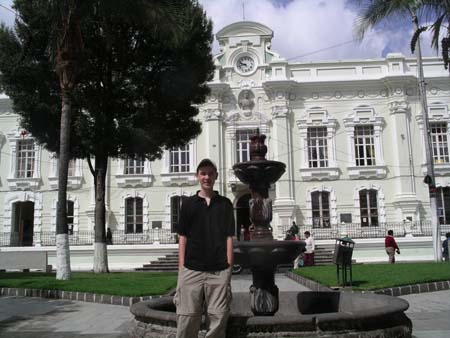
Steve: Today we enjoyed a wonderful and unexpectedly busy day exploring several villages of the Imbabura province. This was a change from our prior days here in the Andean Mountains where we had primarily spent time enjoying Ecuador's natural beauty. Our plan was to get a better sense of how the people here live and work.
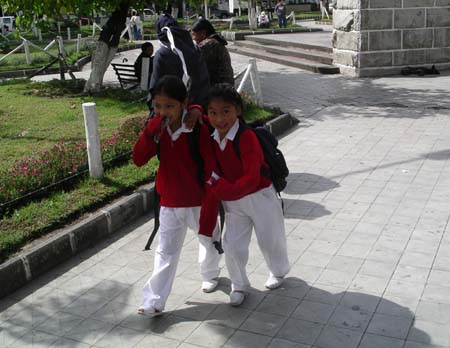 We
began in Otavalo, one of the largest towns in northern Ecuador. Otavalo has
a population of 25,000 and a long history as a trading community. Its extremely
successful Saturday market (that we'll visit tomorrow) has enabled Otavalo
to expand rapidly with many modern buildings and roads. Otavalo sits nestled
in a valley immediately below the Cotacatchi Volcano.
We
began in Otavalo, one of the largest towns in northern Ecuador. Otavalo has
a population of 25,000 and a long history as a trading community. Its extremely
successful Saturday market (that we'll visit tomorrow) has enabled Otavalo
to expand rapidly with many modern buildings and roads. Otavalo sits nestled
in a valley immediately below the Cotacatchi Volcano.
Like all the towns here, Otavalo has a central square framed by a large cathedral
and a municipal building. For some reason, the school children had been released
early today and we enjoyed watching them run and play in the square wearing
their bright red 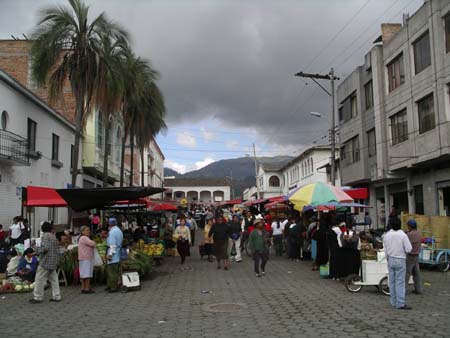 sweater
uniforms.
sweater
uniforms.
Otavalo has a daily food market that was fun to explore. This was our first
visit to a market in South America, and found it to have a very Spanish feel.
This is due to the buildings which are all Colonial Spanish design, the palm
trees and the surrounding 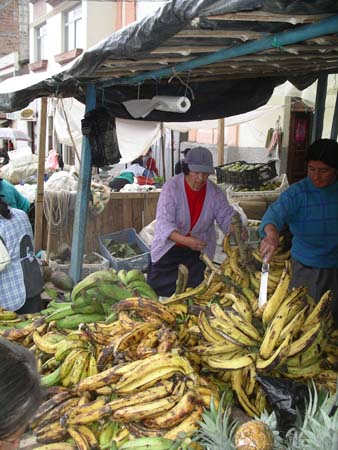 mountains.
It's a very colorful market, primarily selling a wide variety of native fruits
and vegetables that all grow well in Ecuador's excellent soil and climate.
The bananas were particularly impressive, and were some of the biggest we've
ever seen.
mountains.
It's a very colorful market, primarily selling a wide variety of native fruits
and vegetables that all grow well in Ecuador's excellent soil and climate.
The bananas were particularly impressive, and were some of the biggest we've
ever seen.
This trip to the Otavalo market also gave us our first opportunity to really
watch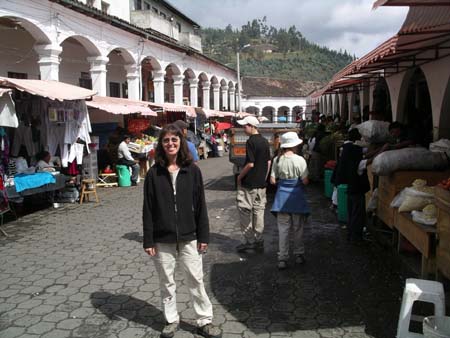 people from several of Ecuador's ethnic communities shop and socialize. These
groups each have their own distinctive dress, and Henry was able to immediately
pinpoint where most people
people from several of Ecuador's ethnic communities shop and socialize. These
groups each have their own distinctive dress, and Henry was able to immediately
pinpoint where most people 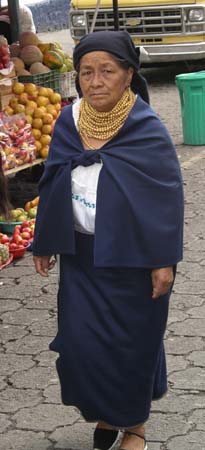 where
from simply by their clothes. The Otavalan women all wear white blouses, blue
skirts and long strands of gold beads - we have found this to be a particularly
beautiful combination, one of the prettiest that we have seen anywhere during
our travels. This region is also different because each ethnic group lives
only in a single village and nowhere else. In Asia, we found ethnic minorities
to inhabit multiple villages, often interspersed with other groups.
where
from simply by their clothes. The Otavalan women all wear white blouses, blue
skirts and long strands of gold beads - we have found this to be a particularly
beautiful combination, one of the prettiest that we have seen anywhere during
our travels. This region is also different because each ethnic group lives
only in a single village and nowhere else. In Asia, we found ethnic minorities
to inhabit multiple villages, often interspersed with other groups.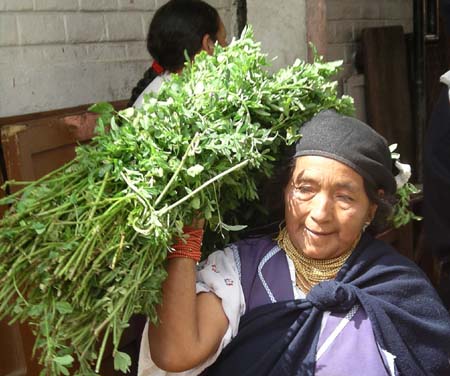
Unfortunately, these women are all extremely camera-shy, but the activity
of today's market gave us an opportunity to begin taking some photographs
to capture their colorful dress. We have also learned that when buying something,
it's always possible to negotiate a photograph as part of the deal - Katie
did this successfully as part of purchasing one of the traditional 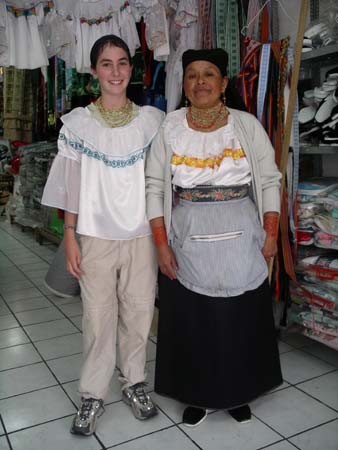 Otavalan
blouses today.
Otavalan
blouses today.
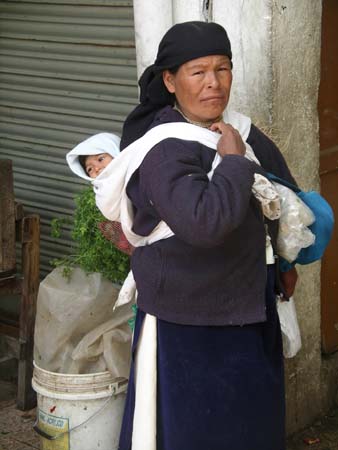
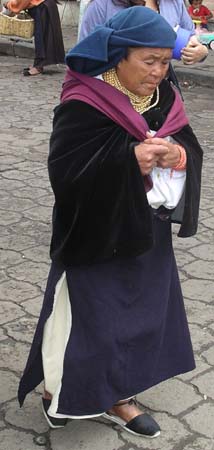
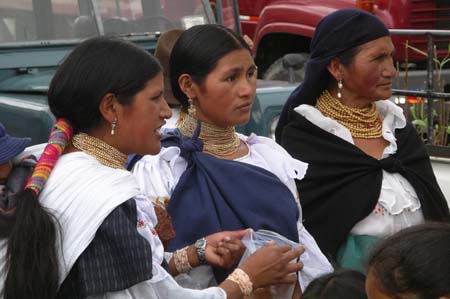
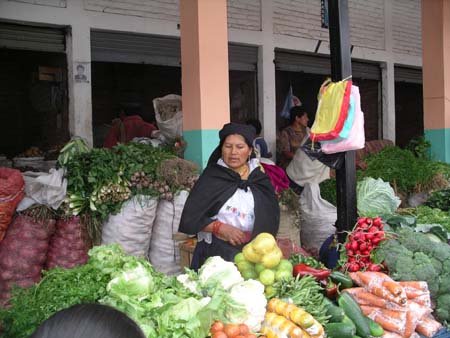
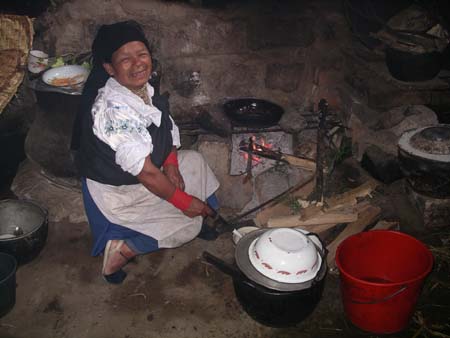
After Otavalo we went to the small village of Peguche, famous for the weavings that are produced by families in their homes. It's also the original site where the Otavalan people first settled in this region. Peguche is a very small and quiet village, and very few people were in the streets today - most were apparently out working in their fields.
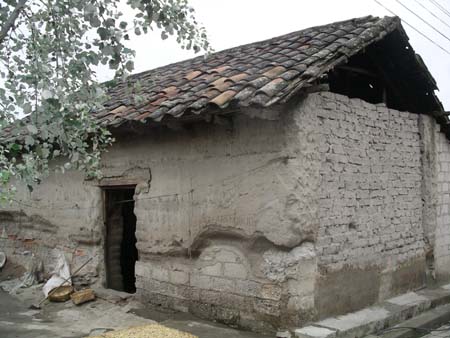 We
stopped for a visit inside a typical home where we visited with a woman and
her mother. The woman was cooking lunch on a small fire inside the home, which
was very dark with no windows (there's ventilation for the smoke at the peaks
of the roof). The home basically consists of one large room that functions
as a kitchen, bedroom and gathering area. It is built of adobe bricks, which
we were able to easily carve into with our fingers - we were amazed that this
material stands up as well
We
stopped for a visit inside a typical home where we visited with a woman and
her mother. The woman was cooking lunch on a small fire inside the home, which
was very dark with no windows (there's ventilation for the smoke at the peaks
of the roof). The home basically consists of one large room that functions
as a kitchen, bedroom and gathering area. It is built of adobe bricks, which
we were able to easily carve into with our fingers - we were amazed that this
material stands up as well 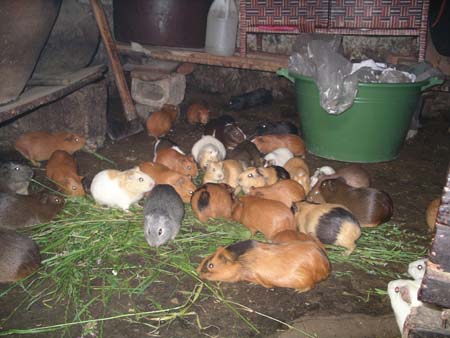 as
it does to rain and wind. Similar to the village homes we saw in Asia, this
family doesn't have many physical possessions - only the basic requirements
for cooking, a few clothes, and straw mats that are placed on the dirt floor
for sitting and sleeping. It was interesting to see the large Inca pots that
the family uses for the storage of food.
as
it does to rain and wind. Similar to the village homes we saw in Asia, this
family doesn't have many physical possessions - only the basic requirements
for cooking, a few clothes, and straw mats that are placed on the dirt floor
for sitting and sleeping. It was interesting to see the large Inca pots that
the family uses for the storage of food.
We had heard that people who live in the highlands keep guinea pigs in their homes for eating, but we were still surprised to see 30-40 of these little creatures running all around this home. As soon as the woman put grass of the floor to feed them, they scurried from all directions to gather for lunch. It was hard for us to imagine how these animals that are kept for pets in America are actually valued here for their meat, particularly for special events such as weddings or birthday celebrations.
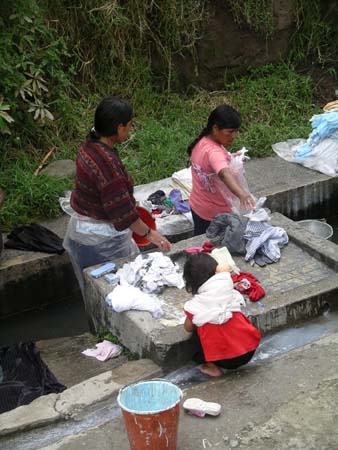 We
walked through Peguche's central square, and also stopped to watch a group
of women washing clothes in a lake-fed stream that runs along the main road
We
walked through Peguche's central square, and also stopped to watch a group
of women washing clothes in a lake-fed stream that runs along the main road
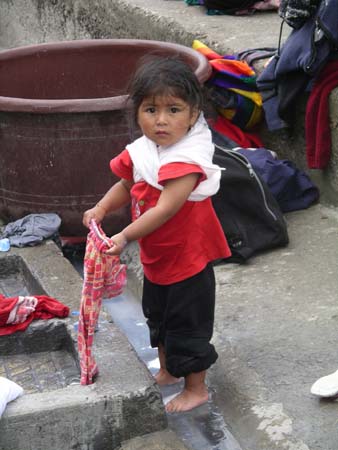 here.
Washing clothes in this way is one of the common activities that we've observed
throughout Asia (and also Morocco). It was interesting to see a young girl
(probably 4 years old with a baby doll strapped to her back just like the
women here) helping her mother. She clearly has been taught at an early age
how to clean clothes in a stream using rocks and brushes.
here.
Washing clothes in this way is one of the common activities that we've observed
throughout Asia (and also Morocco). It was interesting to see a young girl
(probably 4 years old with a baby doll strapped to her back just like the
women here) helping her mother. She clearly has been taught at an early age
how to clean clothes in a stream using rocks and brushes.
We also stopped in the home of a family that apparently is famous for the
production of traditional Ecuadorian instruments. We watched as the father
quickly made a "Gaita", a flute that is made of bamboo. 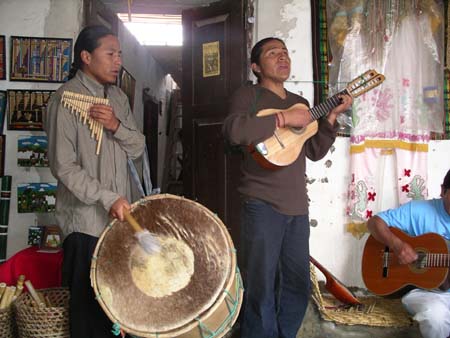 The
family then demonstrated all their instruments and gave us a small musical
performance. Of course, we felt somewhat obliged to buy something, and we
left with a CD recording of their music (which was really quite nice) and
two instruments - a Gaita and a Rondador.
The
family then demonstrated all their instruments and gave us a small musical
performance. Of course, we felt somewhat obliged to buy something, and we
left with a CD recording of their music (which was really quite nice) and
two instruments - a Gaita and a Rondador.
Before lunch, we visited one more village called Quinchuqui. This community
lives on a hillside overlooking Otavalo, and the cement homes are interspersed
among large cornfields. We watched as older women cut down corn stalks by
hand, preparing to haul 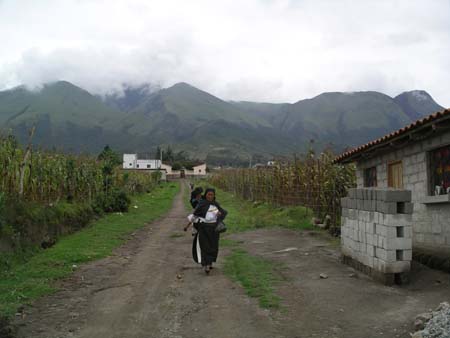 them
to the pastures where they are fed to cattle. This was also a major laundry
day here, and many women carried huge bundles of wet clothes on their backs
uphill to their homes. Everywhere we go, we're always amazed at the heavy
them
to the pastures where they are fed to cattle. This was also a major laundry
day here, and many women carried huge bundles of wet clothes on their backs
uphill to their homes. Everywhere we go, we're always amazed at the heavy
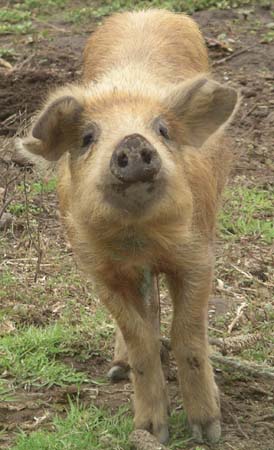 loads
that older women, often in their 80's, carry from place to place.
loads
that older women, often in their 80's, carry from place to place.
We enjoyed lunch at a lodge that overlooks the San Pablo Lake, and then returned
to Hacienda Cusin to rent bikes. The pattern of dry mornings followed by afternoon
rains looked to be developing today, so we quickly got on our bikes and rode
into the town of San Pablo. We initially took the same route from our first
day here, riding to the lake and stopping at an open pasture where people
bring their cows and pigs for the day. We enjoyed playing with a young boy
who was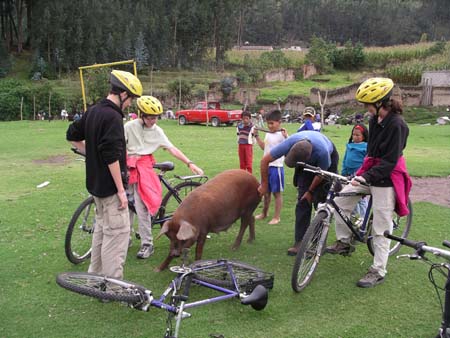 minding his family's large pig, often showing off by actually sitting on the
pig and riding it like a horse (until eventually he took one particularly
dramatic tumble…). Henry tried to put the pig to sleep by scratching
it on its hind quarters, but to no avail (who knows whether this really works,
but it was fun to watch!).
minding his family's large pig, often showing off by actually sitting on the
pig and riding it like a horse (until eventually he took one particularly
dramatic tumble…). Henry tried to put the pig to sleep by scratching
it on its hind quarters, but to no avail (who knows whether this really works,
but it was fun to watch!).
After riding some more and enjoying the view of the lake, we returned through
the town center, past Hacienda Cusin, and along a dirt road that provides
wonderful views of the surrounding mountains and lush green farmland. With
the altitude here, we find that we tire amazingly quickly (even from the 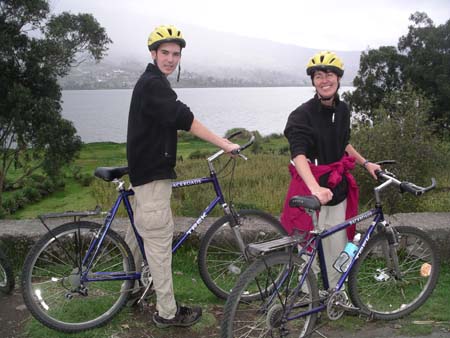 smallest
hill), so we found ourselves taking several breaks. It was all very much worth
it, however, especially when we reached the end of
smallest
hill), so we found ourselves taking several breaks. It was all very much worth
it, however, especially when we reached the end of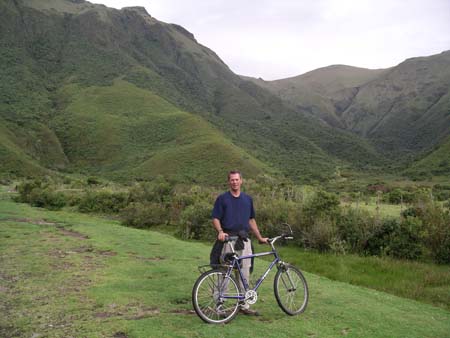 the road to enjoy the spectacular views all around. By now the sun had come
out, turning the mountainsides and valley into a wonderful shade of green.
Henry also heard the sounds of some more interesting birds, but without his
trusty bird-calling CD, it was very difficult to spot them today.
the road to enjoy the spectacular views all around. By now the sun had come
out, turning the mountainsides and valley into a wonderful shade of green.
Henry also heard the sounds of some more interesting birds, but without his
trusty bird-calling CD, it was very difficult to spot them today.
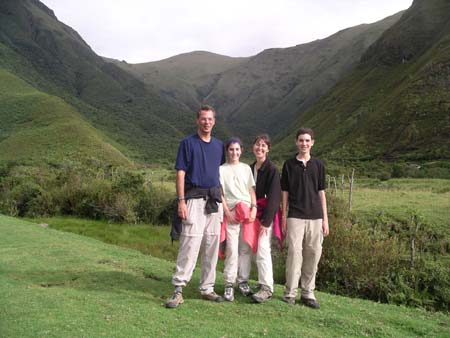 During
our ride back to Hacienda Cusin, we had to negotiate our way by several cows
and large bulls that were being led back to their homes after long days in
pasture.
During
our ride back to Hacienda Cusin, we had to negotiate our way by several cows
and large bulls that were being led back to their homes after long days in
pasture. 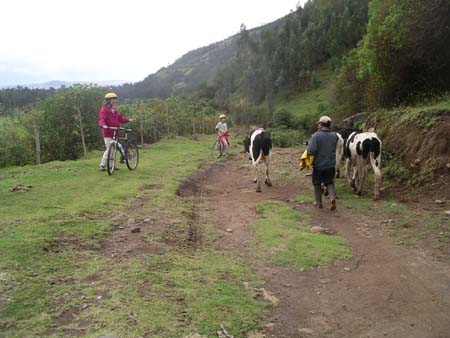 This
was a unique experience for us, and the huge size of these bulls was actually
somewhat intimidating.
This
was a unique experience for us, and the huge size of these bulls was actually
somewhat intimidating.
We made it back to the hacienda, tired and ready to relax before dinner.
However, Henry had spotted parade floats in San Pablo earlier today, and found
out at the office that there was actually a festival happening in the neighborhood
of Gonzalez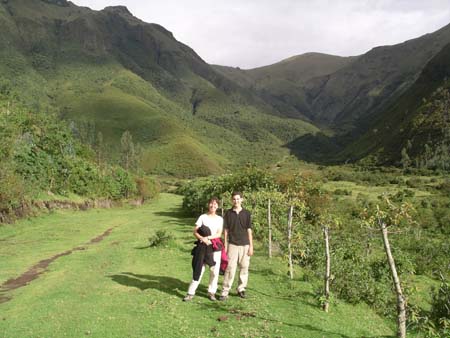 Suarez (part of the overall San Pablo community). Henry asked whether we'd
be interested in riding our bikes there to check out what was happening, and
we quickly decided to go (despite already being very tired).
Suarez (part of the overall San Pablo community). Henry asked whether we'd
be interested in riding our bikes there to check out what was happening, and
we quickly decided to go (despite already being very tired).
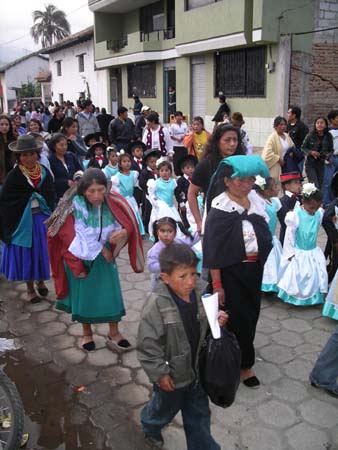 After
a fifteen minute ride (that we expected to only be five minutes) we arrived
to find a wonderful parade underway celebrating the anniversary of San Pablo
becoming part of the Imbabura province. We watched a procession of floats
go by, mainly carrying groups of traditionally-dressed men, women and children
who performed several local dances. This was also a wonderful opportunity
for us to people-watch, as the gathering included members of several neighboring
communities.
After
a fifteen minute ride (that we expected to only be five minutes) we arrived
to find a wonderful parade underway celebrating the anniversary of San Pablo
becoming part of the Imbabura province. We watched a procession of floats
go by, mainly carrying groups of traditionally-dressed men, women and children
who performed several local dances. This was also a wonderful opportunity
for us to people-watch, as the gathering included members of several neighboring
communities. 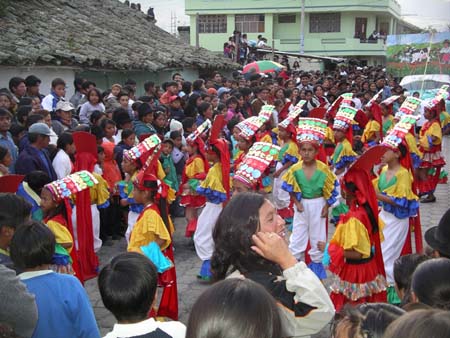 Unfortunately,
the patterns of wet afternoons continued today as it started "raining
on the parade." We had to cut our visit short, but not before we enjoyed
this wonderful opportunity to see local people in a large celebratory
Unfortunately,
the patterns of wet afternoons continued today as it started "raining
on the parade." We had to cut our visit short, but not before we enjoyed
this wonderful opportunity to see local people in a large celebratory 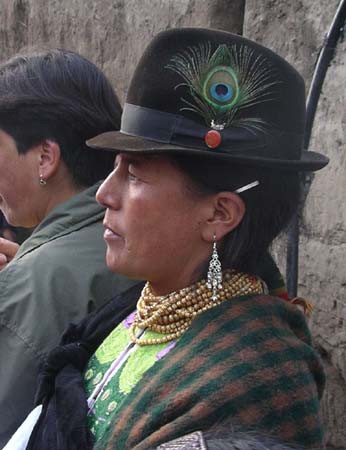 gathering.
We made it through a very wet bike ride back to Hacienda Cusin, and we arrived
wet but very happy at all we had seen and accomplished today.
gathering.
We made it through a very wet bike ride back to Hacienda Cusin, and we arrived
wet but very happy at all we had seen and accomplished today.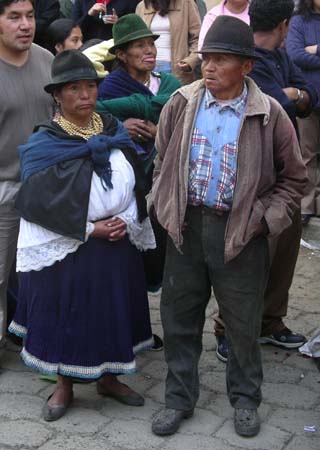
This evening we packed so that we would be ready for an early-morning start tomorrow. We plan to go to Otavalo's famous Saturday market, and need to arrive early for the live animal market that begins at 6:30AM. It should be great fun!
